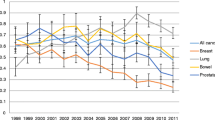Abstract
Background
Previous studies have reported VTE rates during surgical stays in hospitals or by diagnoses over extended periods without being linked to specific surgical events. The purpose of this project was to assess the potential rate of venous thromboembolism in patients with cancer after a surgical procedure within the immediate posthospital admission period of 30 days, with special emphasis in increased sensitivity of detection.
Methods
Patients with cancer who had a major surgery were identified in a large commercial (non-Medicare) database containing data from more than 22 million patients in the United States. Those with a new diagnosis of VTE within 30 days postadmission for surgery were identified. Additional drug-based criteria were used to vary the VTE definition in a sensitivity analysis. VTE rates are reported for each of the surgical procedure group and overall.
Results
The overall 30-day VTE rate was 3.5% with a diagnosis based definition, with rates ranging by procedure from 1.8 to 13.2%. Esophageal resection patients have a VTE rate of 13.2% (95% confidence interval (CI), 8.8–18.9%), whereas prostatectomy patients have a VTE rate of 1.8% (95% CI, 1.5–2.1%). Of the 3.5% of patients with a VTE diagnosis on or before postoperative day 30, 73% of those have the VTE diagnosis by day 14. Another 1.15% is added to the overall VTE rate as the definition sensitivity is increased with outpatient pharmacy claims data.
Conclusions
Using administrative data from large populations provides valuable insight into the potential VTE rates that occur within the 30-day post period after various cancer-related surgeries. The information can be used by surgeons as one component of the benefit-risk decision regarding postoperative VTE prophylaxis in surgical patients.



Similar content being viewed by others
References
AHRQ. Patient safety indicators. http://qualityindicators.ahrq.gov/downloads/psi/2006-Feb-PatientSafetyIndicators.pdf (2006). Accessed 20 Nov 2009.
Silverstein MD, Heit JA, Mohr DN, et al. Trends in the incidence of deep vein thrombosis and pulmonary embolism. Arch Internal Med. 1998;15:585–93.
Douketis JD, Foster GA, Crowther MA, Prins MH, Ginsberg JS. Clinical risk factors and timing of recurrent venous thromboembolism during the initial 3 months of anticoagulant therapy. Arch Intern Med. 2000;160(22):3431–6.
Edelsberg J, Hagiwara M, Taneja C, Oster G. Risk of venous thromboembolism among hospitalized medically ill patients. Am J Health Syst Pharm. 2006;63(20 Suppl 6):S16–22.
Anderson FA, Spencer FA. Risk factors for venous thromboembolism. Circulation. 2003;107(23 Suppl 1):I9–16.
Sweetland S, Green J, Liu B, et al. Duration and magnitude of the postoperative risk of venous thromboembolism in middle aged women: prospective cohort study. BMJ. 2009:339:b4583 doi:10:1136/bmj.b4583.
Hitos K, Fletcher JP. Venous thromboembolism following primary total knee arthroplasty. Int Angiol. 2006:25(4):343–51.
Rasmussen MS, Jorgenssen LN, Willie-Jorgensen P. Prolonged thromboprophylaxis with low molecular weight heparin for abdominal or pelvic surgery. Cochrane Database Syst Rev. 2009;(1):CD004318.
Geerts WH, Bergqvist D, Pineo GF, et al. Prevention of venous thromboembolism: American College of Chest Physicians Evidence-Based Clinical Practice Guidelines, 8th edn. Chest. 2008;133(6 Suppl):381S–453S.
Khorana AA, Streiff MB, Farge D, et al. Venous thromboembolism prophylaxis and treatment in cancer: a consensus statement of major guidelines panels and call to action. J Clin Oncol. 2009;27:4919–26.
Khoranna AA Francis CW, Culakova E, et al. Frequency, risk factors, and trends for venous thromboembolism among hospitalized cancer patients. Cancer. 2007;110:2339–46.
Sallah S, Wan JY, Nguyen NP. Venous thrombosis in patients with solid tumors. Determination of frequency and characteristics. Thromb Haemost. 2002;87:575–9.
Leibson CL, Needleman J, Buerhaus P, Heit JA, Melton LJ 3rd, Naessens JM, Bailey KR, Petterson TM, Ransom JE, Harris MR. Identifying in-hospital venous thromboembolism (VTE): a comparison of claims-based approaches with the Rochester Epidemiology Project VTE Cohort. Medical Care. 2008;46:127–32.
Zhan C, Battles J, Chiang YP, et al. The validity of ICD-9-CM codes in identifying postoperative deep vein thrombosis and pulmonary embolism. Jt Comm J Qual Patient Sat. 2007;33(6):326–31.
Author information
Authors and Affiliations
Corresponding author
Additional information
Funding was provided by Ethicon.
Rights and permissions
About this article
Cite this article
Hammond, J., Kozma, C., Hart, J.C. et al. Rates of Venous Thromboembolism Among Patients with Major Surgery for Cancer. Ann Surg Oncol 18, 3240–3247 (2011). https://doi.org/10.1245/s10434-011-1723-2
Received:
Published:
Issue Date:
DOI: https://doi.org/10.1245/s10434-011-1723-2




